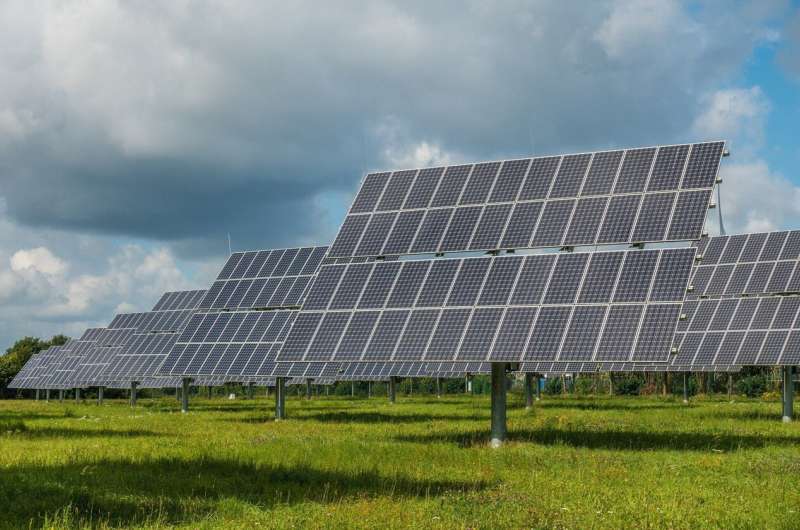Zinc-ion batteries are essential for powering an electric grid which delivers energy even when the sun is not shining or the wind is not blowing. Credit: Pixabay/CC0 Public Domain
Distributed energy resources (DERs) with advanced controls can provide services to the grid such as frequency response. However, to do so, unlike conventional generators, DERs typically have to regularly exchange signals with faraway control centers.
These open communication networks expose the grid to communication delays, cyber threats, and other risks. As DERs are increasingly added to the grid, understanding how long it takes for devices to communicate with control centers and the impacts to maintaining stable frequency on the grid becomes more critical.
At NREL, we are helping bridge the gap between power systems engineering and communications networks. This will be especially important with the anticipated proliferation of DERs as the United States targets 100% clean electricity in 2035 and a net-zero carbon economy in 2050.
Over the past two years, we have investigated the ability of DERs to provide frequency regulation services and, importantly, what happens if their control algorithms do not consider communication variations. We are testing this question through advanced grid modeling and test cases to validate our methodology. This work is supported by the U.S. Department of Energy's Office of Electricity Advanced Grid Research and Development program.
We are finding that, generally, the longer the communication delay between the device and control center, the higher the chance of grid instability—highlighting why it is critically important to understand transmission and distribution dynamics with increasing DERs.
Developing the right co-simulation model
To start to investigate this topic, we first had to develop the right model to simulate distribution and transmission dynamics with high DER deployment—which has not really been explored thoroughly.
The power output of DERs can potentially impact local voltage profiles, so it is important to consider local voltage in DER frequency regulation analysis to avoid issues in distribution networks. However, existing frequency dynamic simulation tools were developed mainly for the transmission system and cannot simulate distribution network dynamics with high penetrations of DERs.
So, we at NREL developed a new framework for DER frequency response analysis based on the open-source Hierarchical Engine for Large-scale Infrastructure Co-Simulation (HELICS) platform. HELICS simulates regional and interconnection-scale power system behaviors by integrating transmission, distribution, and communication domains.
The advantage of our new transmission-and-distribution (T&D) dynamic co-simulation platform is that DERs are modeled explicitly and accurately in both transmission and distribution simulators for frequency and voltage dynamics, respectively. This modeling gives us the perspectives we need to study how DERs can provide frequency response. More details of this T&D dynamic co-simulation model can be found in our article in IEEE Transactions on Smart Grid.
Studying the impact of communication delays
An important aspect of studying DER frequency response is understanding the impact of DER communication delays, or what happens if something goes wrong.
Using our new co-simulation tool in the first phase of our research, we modeled dozens of highly detailed, large-scale scenarios with different degrees of DER communication failures.
We used a synthetic distribution network as our test case, including 40 DERs at every load bus for a total of 19 load buses in the IEEE 39-bus system with 760 DERs. The DER generation was 20% of the loads at every load bus, and the DERs were evenly distributed.
Our results show that just a four-second delay causes system instability when using DERs to provide secondary frequency control after the system loses one conventional generator. In open communication networks, if multiple interruptions occur, such as a communication/routing delay, congestion, or high device response rate, the total delay is at least a few seconds long—and the longer the delay, the higher the risk of instability. If the DER advanced controls design does not consider communication variations, the risk of instability is even greater—again, indicating why it is important to study DER frequency response.
Electric vehicle case study
In another phase of our research, we dug deeper into DER frequency response with a case study on the impacts of electric vehicles (EVs) on power system frequency regulation.
EVs equipped with batteries have the capability and flexibility to (1) provide fast frequency response, (2) help mitigate system frequency fluctuations, and (3) enhance system frequency stability. However, vehicle-to-grid frequency regulation could also impact both the bulk power system frequency response and local distribution network voltage profiles. We wanted to know how EVs could support the grid if a communication failure occurred.
To conduct this case study, we added a new dynamic model to our co-simulation tool to explicitly simulate EV dynamics. We then modeled scenarios with different degrees of communication failures. We found that grid-connected EVs have great potential to restore system frequency, and they can restore it the fastest when they are enabled to change status from fully charging to fully discharging.
These are just a few highlights from our recent analysis of power system operations with widespread DERs, but we have a lot more research ahead of us. Communication networks and the power system are fundamentally intertwined now, yet they have historically been siloed.
The future energy system relies on the communication network, and the communication network relies on the energy system, too. We must work together across disciplines to co-plan operations and ensure that the lights stay on in a low-carbon energy future.
More information: Wenbo Wang et al, Transmission-and-Distribution Dynamic Co-Simulation Framework for Distributed Energy Resource Frequency Response, IEEE Transactions on Smart Grid (2021). DOI: 10.1109/TSG.2021.3118292
Provided by National Renewable Energy Laboratory
























